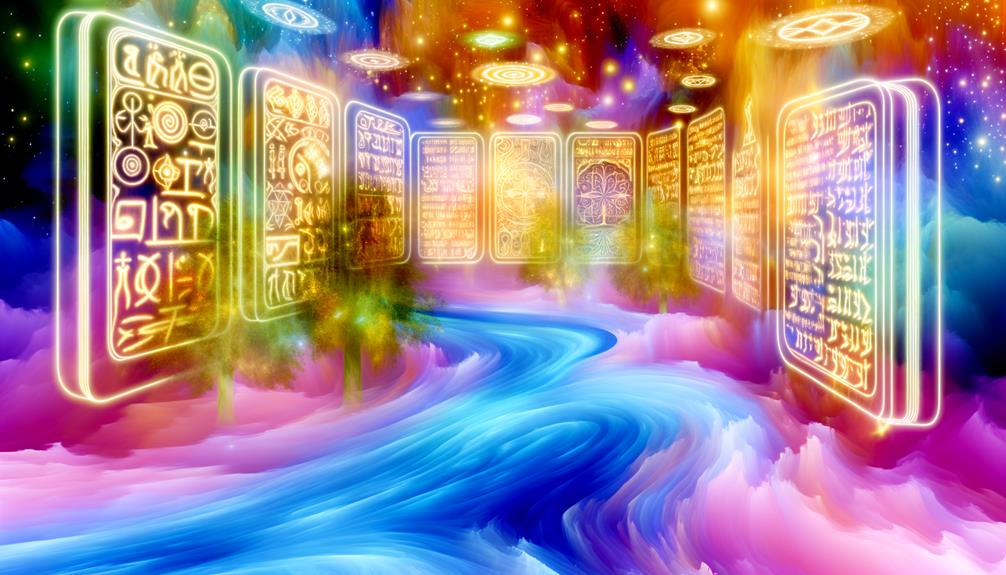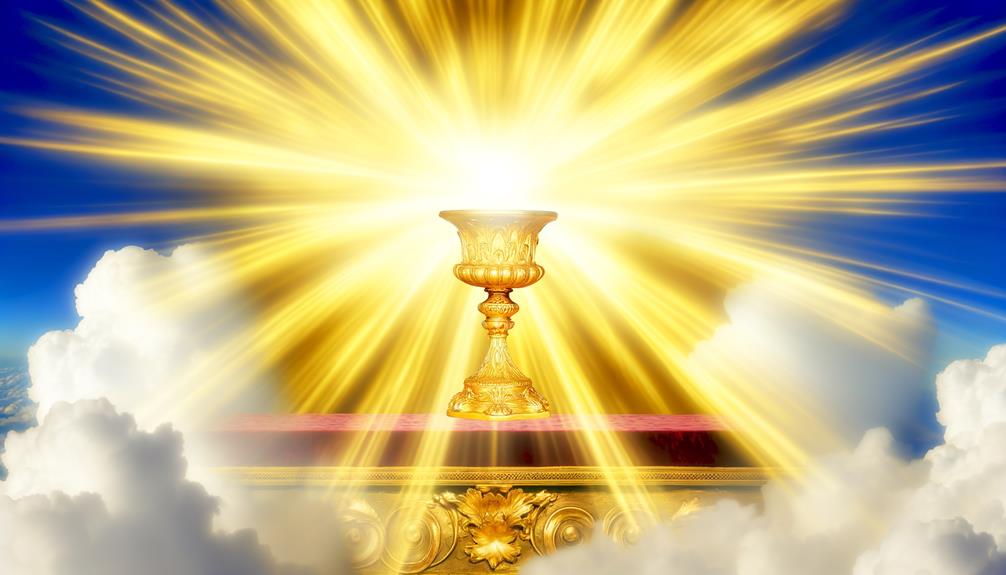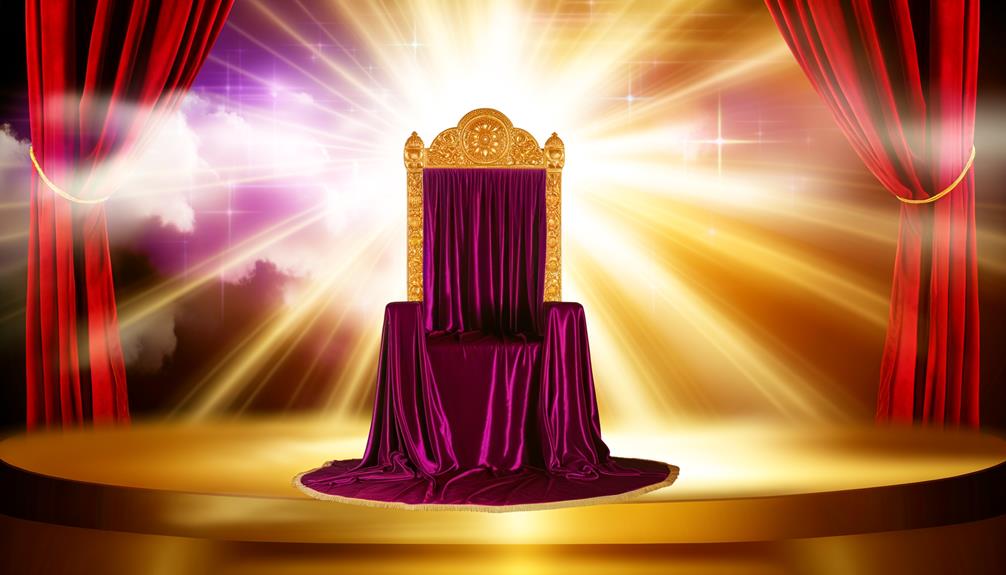Spiritual Meaning of Colors in the Bible: Revelation
The spiritual meaning of colors in the Bible offers profound theological insights. Red signifies redemption and the sacrificial blood of Christ (Hebrews 9:22), while blue represents divine presence and authority (Numbers 15:38-39).
Gold reflects divine glory and purity, used in the Tabernacle and Solomon’s Temple (Exodus 25:10-11). White illustrates purity and holiness, symbolizing victory over sin (Revelation 3:5).
Purple denotes royalty and majesty, as seen in Christ’s mockingly given royal robe (John 19:2). Green symbolizes life, growth, and God’s provision (Psalm 23:2).
These colors disclose deeper understandings of God’s nature and promises throughout scripture. For further exploration, much more is revealed.

Spiritual Meaning of Colors in the Bible: Symbolism and Divine Messages
| Color | Biblical Symbolism and Meaning |
|---|---|
| White | Purity, holiness, righteousness, and victory over sin |
| Red | Blood, sacrifice, atonement, and the love of Christ |
| Blue | Heaven, divine revelation, and the commandments of God |
| Purple | Royalty, priesthood, and God’s majesty |
| Gold | Glory of God, divinity, and eternal value |
| Green | Life, renewal, growth, and restoration |
| Black | Suffering, judgment, sin, and mourning |
| Scarlet | Sin, sacrifice, and redemption through Christ |
Red: Symbol of Redemption

In biblical theology, the color red profoundly symbolizes redemption, frequently representing the sacrificial blood of Christ as depicted in scriptures such as Hebrews 9:22, which states, ‘without the shedding of blood there is no forgiveness.’
This color’s association with atonement is further emphasized in the Passover narrative (Exodus 12:13), where the Israelites marked their doorposts with lamb’s blood to be spared from judgment.
Theologically, red underscores the gravity and cost of salvation, reminding believers of Christ’s ultimate sacrifice.
Additionally, Isaiah 1:18 uses red to contrast sin’s stain with God’s purifying grace: ‘Though your sins are like scarlet, they shall be as white as snow.’
Therefore, red serves as a profound witness to divine mercy and redemption.
Blue: Divine Presence
Often associated with the heavens, the color blue in the Bible symbolizes divine presence and heavenly authority, as evidenced in scriptures such as Exodus 24:10, where the pavement under God’s feet appears sapphire-like, signifying His majestic and transcendent presence. This vivid portrayal underscores blue as a representation of God’s throne and celestial domain.
Furthermore, in Numbers 15:38-39, the Israelites are commanded to wear tassels with a blue cord to remember God’s commandments and their covenant. The blue cord signifies continuous divine oversight and guidance.
Ezekiel 1:26 also depicts a throne with the appearance of sapphire, reiterating blue’s association with divine sovereignty. Consequently, blue in biblical texts consistently highlights God’s omnipresence and supreme authority over creation.
Gold: Divine Glory

As the color blue embodies divine presence, gold in the Bible symbolizes divine glory and the splendor of God’s eternal kingdom. Gold’s luminance and value reflect the divine nature, often associated with God’s majesty and purity.
In the construction of the Tabernacle (Exodus 25:10-11) and Solomon’s Temple (1 Kings 6:20-22), gold is extensively used, signifying a place fit for divine residence. The Book of Revelation (21:18) describes the New Jerusalem with streets of pure gold, symbolizing a paradise of divine brilliance.
| Biblical Reference | Context | Symbolism |
|---|---|---|
| Exodus 25:10-11 | Ark of the Covenant | Divine Presence and Glory |
| 1 Kings 6:20-22 | Solomon’s Temple | Sanctity and Majesty |
| Revelation 21:18 | New Jerusalem | Eternal Glory |
| Daniel 10:5-6 | Vision of a Divine Being | Splendid Radiance |
White: Purity and Holiness
Symbolizing purity and holiness, the color white in the Bible frequently represents the righteousness of God and the sanctification of believers.
This symbolism is evident in Revelation 7:9, where a great multitude stands before the throne, clothed in white robes, signifying their redemption and purity through Christ.
Similarly, white garments in Revelation 3:5 epitomize victory over sin and the promise of eternal life.
Isaiah 1:18 uses white to depict forgiveness, stating, ‘though your sins are like scarlet, they shall be as white as snow.’
The consistent use of white underscores its theological significance, pointing to divine purity, moral integrity, and the transformative power of salvation.
This color, consequently, encapsulates the essence of divine holiness and human sanctification.
Purple: Royalty and Majesty

In the Bible, purple is frequently associated with royalty and majesty, reflecting the high status and divine authority of kings and leaders, as seen in passages like Esther 8:15 where Mordecai wears royal purple garments.
This color’s significance extends to its use in worship, symbolizing the sovereignty of God and the sacredness of priestly duties, as illustrated in the construction of the Tabernacle with purple curtains in Exodus 26:1.
Such scriptural references underscore purple’s role as a profound symbol of power, reverence, and divine ordination.
Biblical Royal Significance
Purple, often associated with royalty and majesty in biblical texts, signifies the divine authority and kingly status ascribed to figures such as King Solomon and Jesus Christ, as evidenced in passages like Esther 8:15 and John 19:2.
In Esther 8:15, Mordecai is adorned in royal purple, symbolizing his elevation to a position of authority and honor.
Similarly, in John 19:2, the soldiers mockingly dress Jesus in a purple robe, inadvertently highlighting His true kingship.
The use of purple in these contexts underscores its role in denoting not just earthly sovereignty but also a deeper, divine ordination.
This color, consequently, serves as a visual representation of God’s chosen leaders and their exalted status within the biblical narrative.
Symbol of Authority
The color purple, recurrently mentioned in scriptural contexts, epitomizes not only the grandeur of earthly monarchs but also the overarching divine authority bestowed by God, as illustrated through various biblical narratives.
In the Old Covenant, purple garments are a symbol of royal status, as evidenced in the attire of King Solomon (Proverbs 31:22) and the luxurious descriptions of the tabernacle (Exodus 26:1). This hue signifies majesty and power, reflecting God’s sovereignty and the conferred authority upon His chosen leaders.
In the New Covenant, purple continues to denote high status, as seen in the parable of the rich man clothed in purple and fine linen (Luke 16:19).
Therefore, purple remains a profound emblem of divine and regal authority throughout biblical scripture.
Purple in Worship
Embodying the divine grandeur and sovereign majesty, the color purple holds a significant place in biblical worship practices, manifesting in the sacred vestments of priests and the adornments of the tabernacle.
Exodus 28:5-6 details God’s command to use purple in the ephod, symbolizing priestly authority and divine royalty. The tabernacle’s curtains, as described in Exodus 26:1, integrate purple yarn, linking it directly to divine presence and sanctity.
In the New Covenant, purple continues to symbolize majesty and reverence, evident in Mark 15:17, where Christ is mockingly adorned with a purple robe, unintentionally affirming His kingship.
Hence, purple in worship underscores themes of divine authority, sacredness, and honor, enriching the theological understanding of biblical color symbolism.
Green: Life and Growth
Green, often seen as a symbol of life and growth in the Bible, signifies renewal and fertility, drawing its profound meaning from scriptures such as Psalm 23:2, where green pastures represent God’s provision and care.
This verdant imagery resonates deeply with the agricultural context of biblical times, highlighting sustenance and divine nurturing. In Genesis 1:30, green plants are given as food, symbolizing sustenance and the continuity of life.
Furthermore, Ezekiel 17:24 speaks of the flourishing tree, a metaphor for God’s people thriving under His covenant.
The theological significance of green extends to eschatological promises, as seen in Revelation 22:2, where the tree of life, bearing continuous fruit, symbolizes eternal renewal and divine sustenance.
Conclusion
In exploring the spiritual significance of colors in the Bible, one uncovers the profound layers of divine symbolism: From the vibrant hues of red, symbolizing sacrifice and love, to the calming blues representing peace and tranquility, each color carries its own unique meaning. Particularly, the spiritual significance of rainbow colors reflects God’s covenant with humanity, serving as a reminder of His promise and presence in the world. By examining these colors, one gains a deeper understanding of the divine messages interwoven throughout scripture.
- Red encapsulates redemption (Isaiah 1:18).
- Blue signifies the divine presence (Exodus 24:10).
- Gold manifests divine glory (Revelation 21:18).
- White epitomizes purity and holiness (Revelation 3:5).
- Purple denotes royalty and majesty (Judges 8:26).
- Green represents life and growth (Psalm 1:3).
Each hue, meticulously chosen, weaves a tapestry of theological depth, inviting deeper contemplation into the mysteries of faith.






